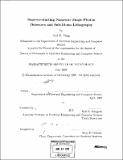Superconducting nanowire single-photon detectors and sub-10-nm lithography
Author(s)
Yang, Joel K. (Joel Kwang wei)
DownloadFull printable version (24.84Mb)
Alternative title
Advancements in superconducting nanowire single-photon detectors and development of fabrication for sub-10-nm lithography
Other Contributors
Massachusetts Institute of Technology. Dept. of Electrical Engineering and Computer Science.
Advisor
Karl K. Berggren.
Terms of use
Metadata
Show full item recordAbstract
Superconducting nanowire single-photon detectors (SNSPDs) are useful in applications such as free-space optical communications to achieve high-speed data transfer across vast distances with minimum transmission power. In this and other applications, SNSPDs with high detection efficiencies are required. To this end, we designed and fabricated an integrated optical cavity and anti-reflection coating that enhanced the detection efficiency of SNSPDs by almost threefold to current record values of 57% at 1550 nm wavelength. We also improved our understanding of SNSPDs by modeling the electro-thermal response of the detector. This model showed that, beyond the initial formation of a photon-induced resistance across the nanowire, Joule heating results in the growth of the resistive segment. While simple, this model was useful in designing SNSPDs that reset more quickly, and also in explaining an undesirable behavior of the SNSPDs where the devices latch into a resistive state and fail to reset. Like many other devices, such as transistors, SNSPDs would benefit from device miniaturization: SNSPDs with narrower nanowires have higher detection efficiencies and increased sensitivity to low-energy photons. In this thesis, we investigated the resolution performance of electron-beam lithography (EBL) by first improving the contrast performance of hydrogen silsesquioxane (HSQ) negative-tone resist. The contrast of HSQ was improved by adding NaCl salt to an aqueous NaOH developer solution. With this improvement, we achieved a high-resolution electron-beam lithography process capable of patterning structures at 9-nm-pitch dimensions. (cont.) The ability to pattern sub-10-nm structures is useful for fabricating future high-performance SNSPDs, nanoimprint lithography molds, prototypes of next generation transistors and storage media, and templates for controlling the self-assembly of block copolymers (BCPs). While this EBL process affords high-resolution, it is inherently a low-throughput process due to the serial nature of the pattern exposure. As a result, EBL is not cost effective in fabricating densely-patterned devices in large volumes. However, coin-bining this top-down EBL process with bottom-up BCP self-assembly techniques, we can simultaneously achieve high resolution without sacrificing throughput or pattern registration. We demonstrated that high-throughput fabrication of a hexagonally-ordered array of posts could be achieved by patterning only a sparse array of posts with EBL and using block copolymers to complete the missing structures.
Description
Thesis (Ph. D.)--Massachusetts Institute of Technology, Dept. of Electrical Engineering and Computer Science, 2009. Cataloged from PDF version of thesis. Includes bibliographical references (p. 155-169).
Date issued
2009Department
Massachusetts Institute of Technology. Department of Electrical Engineering and Computer SciencePublisher
Massachusetts Institute of Technology
Keywords
Electrical Engineering and Computer Science.